西班牙是一个如红色骄阳般的热情国度,也许它不及法国浪漫,不及英国绅士,但它无与伦比的热情、奔放、高贵与狂野彰显了独特的西班牙之魅。无论是斗牛士手中挥舞的红色斗篷,还是弗拉门戈舞女郎飞扬的艳丽裙角,抑或是毕加索笔下划时代的立体派绘画,都淋漓尽致地展现了浓郁的西班牙风情……
Bull Fighting 斗牛——死亡之舞
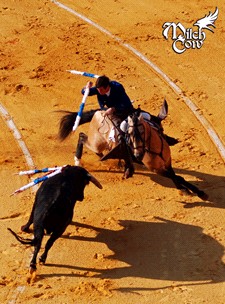 Whenever we think about Spain, a picture of a Bull-fighter with a red cloth in hand and a bull charging towards it comes in our mind. Bull fighting has truly become a symbol of this European country.
Whenever we think about Spain, a picture of a Bull-fighter with a red cloth in hand and a bull charging towards it comes in our mind. Bull fighting has truly become a symbol of this European country.
The basis of bull fighting in Spain lies in an age-old tradition in which people used to sacrifice a bull on the days of fiestas1). And this game originally started as a playful competition between people and their bulls.
The professional form of this sport started in 711 A.D. to celebrate the crowning ceremony of King Alfonso VIII. At that time, the sport was played while riding a horse. It was then a sport for aristocrats, but King Felipe V banned them from playing this sport as he thought that it created a bad example for the people.
Once the aristocrats were banned from the sport, common people started taking part in the Bull Fighting. As common people couldn’t afford to keep horses, they changed the rules of the game. Thus, the present version of the game was created in 1724. In this version, the player dodges2) the raging bull on foot and unarmed.
Ever since that time, bull fighting in Spain has been one of the most beloved sports. Thousands of people flock to the bull ring to watch this intense and entertaining competition between man and animal.
The matador3) is regarded as the greatest of sportsmen in the country as the act of jumping into a ring with a huge bull requires quite a bit of courage. Many times, matadors can get seriously injured while fighting with the bull. This sport causes several deaths and disabling injuries every year. This is why a bull fighting match is also known as the dance of death. Despite the danger, its popularity has only increased over the years.
Today, bull fighting has become a highly organized sport in Spain. Even though there are many organizations which consider this game to be cruelty towards animals, this has not diminished the craze of people towards this sport. 一想到西班牙,斗牛士手执红布、公牛低头冲锋的画面就会浮现在我们脑海中。毫无疑问,斗牛已成为西班牙的象征。
在西班牙早年的宗教节日中,人们常常把牛作为祭祀品,而西班牙斗牛就起源于这一古老的传统。斗牛运动的最初形式是人和牛之间有趣的竞技游戏。
公元711年,为庆祝国王阿方索八世的加冕典礼,职业斗牛运动拉开了序幕。那时,人们是骑着马与公牛进行角逐。其时的斗牛也常常只是贵族的特权。后来,国王费利佩五世认为贵族斗牛会给人们树立不好的榜样,便下令禁止贵族再从事这项运动。
当贵族失去了斗牛的特权,老百姓便开始纷纷加入斗牛的行列。老百姓没钱养马,就改变了斗牛的规则。于是,1724年,新形式的斗牛运动诞生了,这也是目前斗牛所遵循的形式。在新的斗牛运动中,斗牛士躲避狂怒的公牛时不骑马,也不携带任何武器装备。
从那以后,斗牛成为西班牙人最为钟爱的运动之一。成千上万的观众涌入斗牛场,观赏人与牛之间激烈而有趣的角逐。
斗牛士被视为西班牙最伟大的运动员,因为他们勇气非凡,敢于进入斗牛场与体格硕大的公牛较量。在与公牛的激烈搏斗中,斗牛士常常会身受重伤。每年,这项运动都会导致多起死亡事故,也有很多人因此受伤致残。这也正是斗牛又被称做“死亡之舞”的原因所在。虽然如此,斗牛的受欢迎程度却与日俱增。
今天,斗牛在西班牙已成为高度组织化的运动。尽管有许多团体组织认为斗牛是对动物的残害,但这并未减少人们对这项运动的狂热之情。
Flamenco 弗拉门戈舞——西班牙之魅
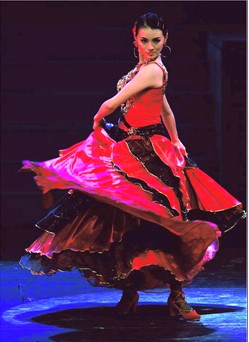 Flamenco is a Spanish art form with roots deep in Andalusia—Spain’s southern region. Although there are clues as to how this dance and folk music evolved, the details are lost in history.
Flamenco is a Spanish art form with roots deep in Andalusia—Spain’s southern region. Although there are clues as to how this dance and folk music evolved, the details are lost in history.
Even the origin of its name is elusive. Some attribute it to the early 1500s and the Flemish4) courtiers5) during the reign of Spain’s King Charles V. Their bright clothing inspired the names given to garish or conspicuous things, such as flamingoes6) and flamenco. Others say flamenco was the nationality erroneously given by the common people to Gypsies. Still others claim the name comes from the Arabic “fellah mangu”—the laborer who sings.
Flamenco combines acoustic guitar playing, singing, chanting7), dancing and handclapping. The flamenco dancer performs with passion, fervor, and even tortured expressions, but is always striving for grace and dignity.
The guitar and the rapid rhythmic handclapping of the singers and dancers set the scene8). Flamenco handclapping produces a sharp, almost piercing sound. The dancer does not begin immediately, but waits, absorbing the strumming, clapping and singing until inspired to dance.
Like American jazz, flamenco dancing involves improvisation9). It’s the dancer’s spontaneous expression of the moment’s emotions. The Spanish call it “duende”. The word means goblin10) or fairy, but to the flamenco dancer it signifies an inner force that fuels an inspired performance.
作为西班牙独有的艺术形式,弗拉门戈舞起源于西班牙南部地区安大路西亚。尽管这种舞蹈和民间舞曲的发展尚有线索可循,但其中的细枝末节却早已淹没在历史的长河中了。
就连“弗拉门戈舞”这一名称从何而来也无从考证了。有人认为该名字起源于16世纪早期,与西班牙查尔斯五世统治时期的侍臣佛兰德人有关。这些佛兰德人衣着鲜亮华丽,于是许多艳丽、醒目的东西皆以他们的名字命名,比如说弗拉明哥鸟(火烈鸟)和弗拉门戈舞。有的人则认为这源于人们对吉卜赛民族的错误称呼,错将其叫成了弗拉门戈。还有人认为弗拉门戈来自于阿拉伯人对于唱歌的劳动者的称呼——弗拉曼古。
弗拉门戈舞融木吉他弹奏、歌唱、吟唱、舞蹈和击掌于一体。弗拉门戈舞者在表演时激情四溢、热情奔放,脸上的表情甚至带着点痛苦不堪,但他们总是努力表现得优雅自如、高傲尊贵。
吉他弹奏加上歌者和舞者节奏明快的击掌,为弗拉门戈舞表演揭开了序幕。弗拉门戈舞的击掌声尖锐清脆,极具穿透力。舞者不会即刻开始舞蹈,而是慢慢等待,聆听并感受周围的吉他声、击掌声和歌声,待到灵感顿现,火热的舞蹈便开始上演。
和美国爵士乐一样,弗拉门戈舞中也包括即兴表演的成分。舞者把在瞬间体会到的情感通过舞蹈即时地释放出来。西班牙人把这种即兴创作的方式称做“duende”,意思是小精灵或仙女。但对于弗拉门戈舞的舞者来说,它象征着一种内心的力量,正是这力量激发出激情四溢的表演。
Pablo Picasso帕布罗·毕加索——立体主义绘画大师
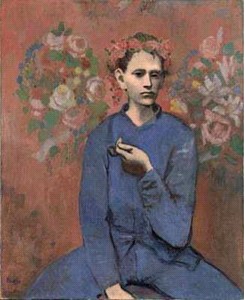 Pablo Picasso was a pioneer and a protean11) master, with a hand in every art movement of the 20th century. He is best known for co-founding the Cubist12) movement and for the wide variety of styles embodied in his work. He was born in Malaga, Spain in 1881. When he died in 1973, he was ninety-one years old. In his final days, he still took up his paints and brushes to start a new picture as if he were seeing things for the first time.
Pablo Picasso was a pioneer and a protean11) master, with a hand in every art movement of the 20th century. He is best known for co-founding the Cubist12) movement and for the wide variety of styles embodied in his work. He was born in Malaga, Spain in 1881. When he died in 1973, he was ninety-one years old. In his final days, he still took up his paints and brushes to start a new picture as if he were seeing things for the first time.
Picasso demonstrated uncanny13) artistic talent in his early years, painting in a realistic manner through his childhood and adolescence; during the first decade of the twentieth century his style changed as he experimented with different theories, techniques, and ideas. Picasso’s creativity manifested itself in numerous media, including painting, sculpture, drawing, and architecture. His revolutionary artistic accomplishments brought him universal renown and immense fortunes throughout his life.
To say that Pablo Picasso dominated Western art in the 20th century is an understatement. Before his 50th birthday, the little Spaniard had become the very prototype of the modern artist as public figure. No painter before him had had a mass audience in his own lifetime. The total public for Titian14) in the 16th century or Velazquez15) in the 17th was probably no more than a few thousand people. Picasso’s audience was in the tens, possibly hundreds, of millions. He and his works were the subjects of unending analysis, gossip, dislike and adoration.
帕布罗·毕加索是一位先驱和多才多艺的画坛巨匠,他参与了20世纪美术界的每一次运动。他最大的声誉来自于他是立体主义运动的发起人之一,也来自于他多变的作品风格。毕加索1881年出生于西班牙的马拉加。1973年他逝世时,已经91岁了。但即便在生命最后的时光里,他依然会拿起颜料和画笔创造新的作品,仿佛第一次见识这个世界。
毕加索在很小的时候就显示出超凡的艺术天赋。在童年和青少年时期,他的作品一直是写实主义风格;到了20世纪早期,在接触了各种各样的理论、技巧和观念后,他的绘画风格发生了转变。毕加索在众多领域内显示了他的创造性,包括油画、雕塑、素描和建筑等。众多开创性的艺术成就为他的一生赢得了广泛的赞誉和巨大的财富。
即便到今天为止,说20世纪的西方艺术由帕布罗·毕加索一统天下,也丝毫不为过。这个身材矮小的西班牙人在不到五十岁时就已经是现代艺术家的完美典范。在毕加索之前,没有任何一个画家在生前就拥有如此多的观赏者。16世纪观赏过提香作品的人和17世纪观赏过委拉兹开斯作品的人加起来也不过寥寥几千人。毕加索的观赏者则有几千万甚至几亿之多。毕加索其人和他的作品是人们评析、谈论、憎恶和爱慕的永恒对象。
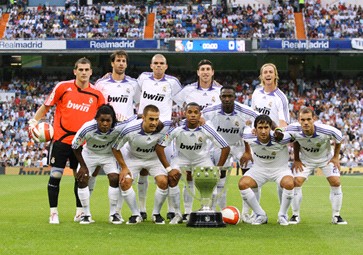
Real Madrid 皇家马德里——足球界的“银河战舰”
Founded in 1902, Real Madrid Club de Futbol has been one of the superpowers in European football since the middle of the last century. Indeed, they were awarded the honour of “Best club of the 20th century” by FIFA16), an award for their huge domestic success and also for their domination of Europe. “Real Madrid” has not always been the club’s name—the “Real” part of the name was only added after the club received a blessing17) from King Alfonso XIII in 1920.
The club’s success really started under the Franco18) regime—he saw the club as an excellent propaganda vehicle and poured resources into the club to try to make them a dominating force in Spain and beyond. Probably Madrid’s finest period came between 1955 and 1960 when they won an unprecedented five European Cup’s in a row. This really put the club on the map19) as a dominant force in Europe and no club has matched the feat since. Probably the finest display came during this period in the 1960 final where they demolished20) their German opposition, Eintracht Frankfurt, 7-3. Real have since gone on to win the trophy four more times, and their total of 9 is better than any other team. Amongst Real Madrid’s domestic honours are a massive 29 league titles and 17 Spanish cup triumphs, equally unrivalled by any team in Spain.
皇家马德里足球俱乐部创立于1902年。自上世纪中叶起,皇马已经成为欧洲足球领域的“超级大国”之一,甚至还被国际足球联合会授予了“20世纪最佳俱乐部”的称号。这既是对于球队国内赛事胜绩的肯定,也是对于它雄踞欧洲之首地位的认可。皇家马德里的本名并非如此,“皇家”二字是俱乐部在1920年获得国王阿方索十三世的首肯后才加上去的。
皇马的成功始于佛朗哥统治时期。佛朗哥把该俱乐部视为绝佳的宣传工具,对其投入了大量财力,努力使之成为西班牙乃至全欧洲最强大的球队。皇马最为辉煌的时期大概是在1955至1960年,其间球队连续五次捧得欧洲杯,这是史无前例的战绩。皇马因此声名远扬,成为欧洲雄居榜首的球队,其他任何俱乐部都没能再创这样的佳绩。皇马最为出色的表现是在1960年与德国队的一场决赛,当时球队以7:3的悬殊比分使德国法兰克福队溃不成军。自此以后,皇马又四次捧回欧洲杯,总计夺冠九次的佳绩超越了其他所有球队。皇马在国内的战绩包括29次联赛冠军和17次西班牙杯冠军。在西班牙,没有任何一支球队可望其项背。
Paella海鲜饭——美食大杂烩
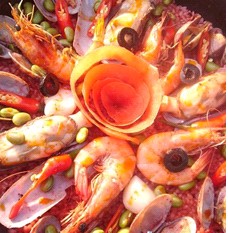 If you are looking for a traditional Spanish recipe, without doubt, the best-known is the prodigious21) paella—that tasty, adaptable, gregarious22) dish famed throughout Spain and the World.
If you are looking for a traditional Spanish recipe, without doubt, the best-known is the prodigious21) paella—that tasty, adaptable, gregarious22) dish famed throughout Spain and the World.
Paella originated in the countryside long ago. Farmhands made a fire in fields at lunchtime and simmered23) the local short grained rice in a flat pan. They added whatever edibles were at hand —snails might be added as well as artichokes24) and other local vegetables, or perhaps a stray25) chicken or a rabbit caught in the fields. Along the shore, fishermen would embellish26) their paellas with fish and seafood.
As tourists from other parts of Spain vacationed on the Mediterranean coast in the summer, the dish spread throughout other regions of Spain. Variations have evolved to include locally available produce27). In Sevilla and Cádiz they add big prawns and langostinos. Along the Costa del Sol28), mussels, prawns, nora peppers and lemons became favored ingredients. Today, paella has universal appeal with literally hundreds of regional variations.
如果要寻访传统的西班牙美食,毫无疑问,最有名的就是份大量足的海鲜饭了。海鲜饭味道鲜美,风味多变,适合多人享用,无论在西班牙还是在全世界,都享有盛誉。
很久以前,海鲜饭诞生在西班牙的乡间。中午时分,农夫在田地里生火,把当地的短粒米放在平底锅中慢煮,然后将手边任何可吃的东西加入锅中——蜗牛、洋蓟和其他当地蔬菜;也许偶尔还能将田间抓到的跑单的小鸡或者兔子放入锅中。在沿海地带,渔夫还会将鱼和海鲜加到海鲜饭中来“装点”佳肴。
在炎炎夏日,其他地区的西班牙人到地中海沿岸度假,这使海鲜饭在西班牙更多地区得以风行。海鲜饭的风味在加入当地的菜蔬后会有所变化。在西班牙的塞维利亚和加的斯,人们在海鲜饭中加入大明虾和海螯虾。在阳光海岸,贻贝、明虾、诺拉辣椒和柠檬都成为人们喜爱的海鲜饭成分。今天,有着几百种地方风味的海鲜饭让全世界的人为之倾倒。
1. fiesta [fI5estE] n. 宗教节日
2. dodge [dCdV] vt. 避开,躲避
3. matador [5mAtEdC:] n. 斗牛士
4. Flemish [5flemIF] adj. 佛兰德的,佛兰德人的。佛兰德人为佛兰德斯地区(中世纪欧洲一伯爵领地, 包括现比利时的东佛兰德省和西佛兰德省以及法国北部部分地区)的六百多万居民的称呼。
5. courtier [5kC:tjE] n. 朝臣,奉承者
6. flamingo [flE5mIN^Eu] n. [动]火烈鸟
7. chant [tFB:nt] vi. [音乐]吟唱,唱
8. set the scene:(为……)作好准备
9. improvisation [7ImprEvaI5zeIFEn] n. 即兴创作
10. goblin [5^CblIn] n. 顽皮的丑小鬼,小精灵
11. protean [prEu5ti:En] adj. 变化多端的,多才多艺的
12. cubist [5kju:bIst] adj. 立体派的
13. uncanny [Qn5kAnI] adj. 离奇的,神秘的
14. Titian:即提香·韦切利奥(Tiziano Vecellio, 1478~1576),意大利文艺复兴盛期威尼斯画派的代表性画家
15. Velazquez:即迭戈·委拉兹开斯(Diego Velazquez, 1599~1660),西班牙杰出的绘画大师
16. FIFA:国际足球联合会(Federation International Football Association)
17. blessing [5blesIN] n. 同意,允许
18. Franco:佛朗哥(1892~1975), 西班牙军人和政治领袖,1939~1975年间为国家元首,在西班牙实行独裁统治。
19. put … on the map:使……出名
20. demolish [dI5mClIF] vt. 推翻,铲除,彻底除去
21. prodigious [prE5dIdVEs] adj. 巨大的
22. gregarious [^rI5^eErIEs] adj. 社交的,群居的
23. simmer [5sImE] vt. 慢煮
24. artichoke [5B:tItFEJk] n. [植] 洋蓟(地中海地区的一种菊科蓟类植物)
25. stray [streI] adj. 迷路的,离群的
26. embellish [Im5belIF] vt. 修饰
27. produce [5prRdju:s] n. (尤指新鲜水果、蔬菜等)农产品
28. Costa del Sol:阳光海岸,直布罗陀海峡东北的西班牙南部沿岸,欧洲著名的度假胜地
